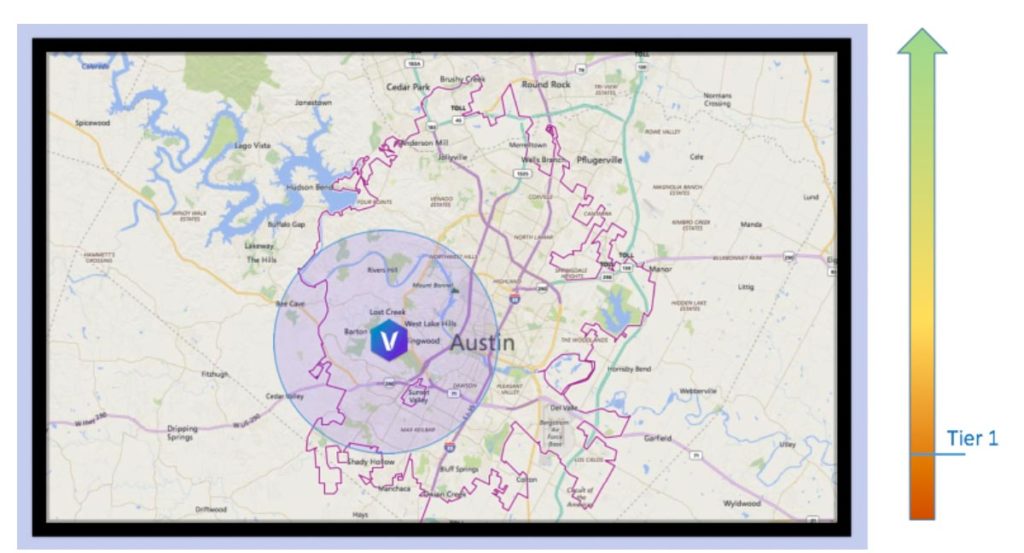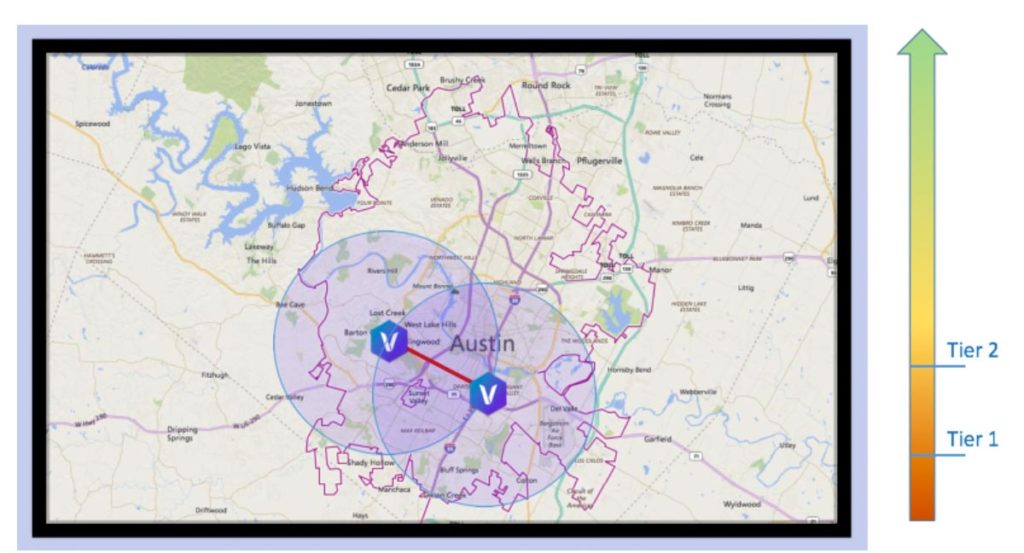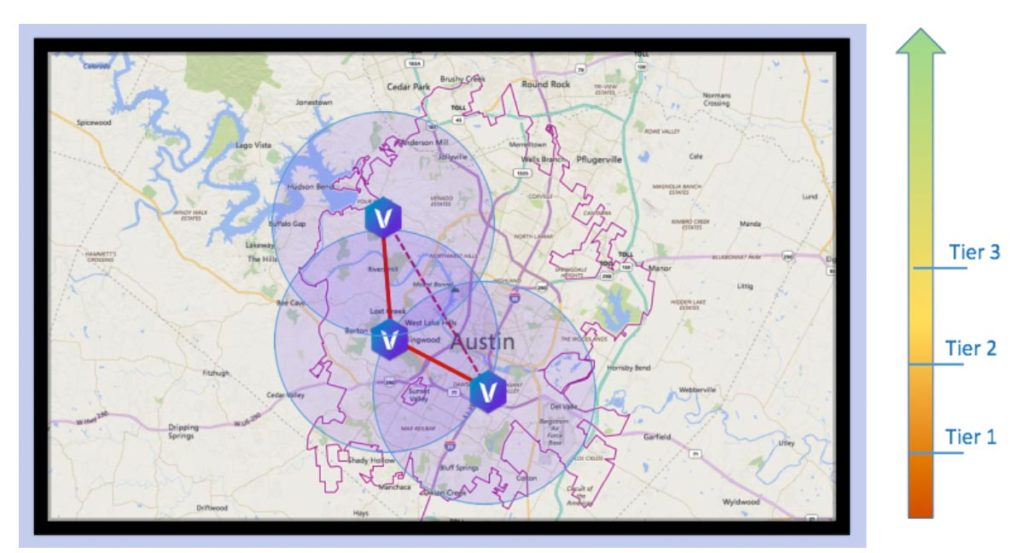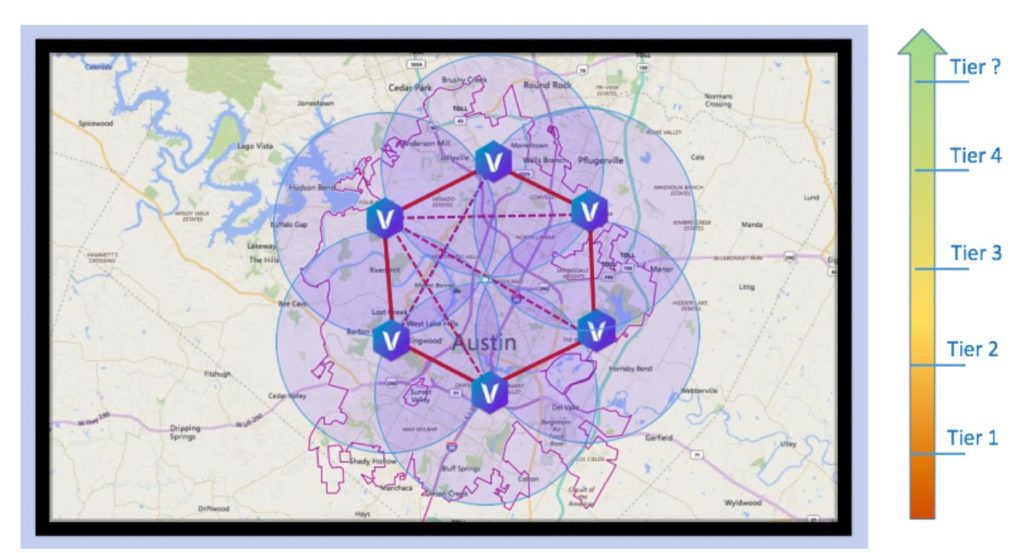Today we announced the Vapor IO Kinetic Edge™, a technical architecture for combining multiple Vapor IO micro data centers into a virtual data center that can span an entire city and deliver a record-breaking twelve or more nines of availability.
Vapor IO’s Kinetic Edge is a new kind of infrastructure architecture that uses software and high-speed connectivity to combine multiple micro data center facilities into a single “logical data center.” For developers and operators, it presents a geographically-dispersed collection of micro data centers as a single virtual facility with multiple availability zones.
An Architecture Built for Edge
Vapor IO’s Kinetic Edge architecture creates city-sized, software-controlled virtual data centers comprised of many micro data centers meshed together with high-speed fiber, spanning an entire geographic region.
Take for example, Austin, TX, where Vapor IO has its headquarters. If we were to place single Vapor Edge Module with N+1 redundancy, it would approximate a Tier 1 data center. (Note: this is a conservative assessment as a Tier 1 data center, as defined by the Uptime Institute, has no redundancy. Even though a single Vapor Edge Module has N+1 redundancy, it’s still a single point of failure.)
If we add a second Vapor Chamber or Vapor Edge Module to region, we can strategically locate it 10 Km to 20 Km away from the first location and connect them with high-speed fiber:
By picking the location of the two sites strategically, we can draw power from multiple substations, effectively creating redundant A and B power feeds for each location. The high-speed fiber connectivity, lets us treat the separate micro data centers as, essentially, availability zones in the Austin city region. Using the same techniques as on public clouds like Amazon Web Services, we can add resilience to our applications by replicating data and load balancing across availability zones; and if one fails, we can recover by restarting workloads in the remaining micro data center. With a second Vapor location, we can approximate, conservatively, a Tier 2 data center.
If we continue our expansion and add a third location, again connected by high speed fiber, we add another availability zone and another level of redundancy and now we’ve approximated a Tier 3 data center..
By repeating this process, we can add more micro data centers and continue connecting them with redundant fiber paths. By the time we get to five locations in a metropolitan region we’ve approximated 12 nines of reliability (99.9999999999% uptime) and we’ve exceeded the level of Tier 4 reliability:
The Kinetic Edge, Concisely Defined
A Kinetic Edge consists of:
- Multiple Vapor Chambers or Vapor Edge Modules, spaced 10 Km to 20 Km apart
- High-speed site-to-site fiber connectivity with redundant paths
- Vapor Edge Controllers in each location that manage the fiber connectivity and present software APIs that expose edge conditions in real time
- Software for IP aggregation at the edge, as well as for site-to-site handoff of IP addresses to support devices in motion, as well as for migrating network traffic for load balancing and failover
- Ingestible telemetry for application and container orchestration integration
Developers use the Vapor Edge APIs to build edge native applications that respond to changing environmental conditions, delivering software-based high-resiliency failover, real time load balancing, workload migration for devices in motion, and so on.
The Highly-Available Edge
We all know that traditional data centers are made more resilient by expensively replicating critical systems at each site. For example, a 2N+1 site would require three of everything—generators, backup batteries, cabling, cooling systems, and so on.
The Kinetic Edge is a revolutionary advancement in resilience. By combining multiple nearby sites that have no redundancy, we can use software and high-speed fiber to seamlessly combine them so that, in aggregate, they collectively exceed the availability of the most reliable Tier 4 data centers.
We believe all edge data centers that deliver reliable cloud services will need to be built with a Kinetic Edge. In the future, reliability will increasingly be achieved by distributing risk across all sites in an edge region and using software to monitor environmental conditions and replicate workloads and data so that there is no single point of failure.








